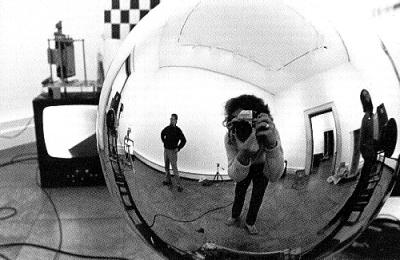Magical Machines
dal 4/7/2002 al 8/9/2002
Segnalato da
Gregory Barsamian
Marcel Duchamp
Christoph Keller
Paola Pivi
Steina Vasulka
Herwig Weiser
4/7/2002
Magical Machines
Edith-Russ-Haus for Media Art, Oldenburg
A desire for the extraordinary, which is at the core of any fantastic machine, travels through this exhibition as an undercurrent and is often transferred to the viewer as an experience for the senses. The Edith Russ Site for Media Art has brought together sculptures and apparatuses with a strong physical presence.

Gregory Barsamian (USA), Marcel Duchamp (F), Christoph Keller (D), Paola Pivi (I), Steina
Vasulka (USA/Island), Herwig Weiser (A)
A desire for the extraordinary, which is at the core of any fantastic machine, travels through this exhibition as an
undercurrent and is often transferred to the viewer as an experience for the senses. At a time when the word virtual
constantly slips into the discourse on art, the Edith Russ Site for Media Art has brought together sculptures and apparatuses
with a strong physical presence. They are possibilities of artistic invention from the dynamism of the object to the
development of utopian idea for a better world through mechanical artworks. The Magical Machines are a testament to the
hope for the endless source of the inventive spirit.
It was no accident that Marcel Duchamp (F) first exhibited his Rotoreliefs" (1935/65) at a fair for inventors. With this act, he
rejected painting and initiated the mass production of his work, taking his historical place in the world of inventors. The
colorful patterns of his discs spontaneously dissolve from only a few simple lines, a martini glass appears and fluctuate
betweena two and three dimensions. Their circling movement animates the change, making it possible for the visitors to
place the Rotoreliefs on Duchamps turntable and experience music made for the eyes instead of the ears.
Artists also provoked a discussion on tradition and new genres through their use of video. The electro/opto/mechano
installation Allvision" (1976) by Steina Vasulka (Iceland/USA) is an early artistic experiment in which the video medium was
investigated as a new manner of seeing. The space is surveilled from every angle via turning cameras and a mirrored ball,
playfully distorting the visitor and the surrounding space. Time and movement become a single universe of endless cycles
and satellites. This machine vision (Vasulka) expands the possibilities of artistic worlds.
Those who see the world through the focus of their own large or small inventions and nervously search the halls of the
patent office for earlier patents that could potentially stand in the way of their own claims may be the last utopians. The
visions of these artists, the private inventor at the patent office, are also private utopias. Christoph Kellers patented
Helioflex" (1997) shows the development of a project that brightens densely built spaces with sunlight. The Helioflex sun
mirror automatically steers direct sunlight into dark apartments and shadowy gardens. It is composed of tested components
such as satellite systems and follows the sun with a simple, robust tracking system. For Magical Machines Keller (D) will
show the papers and plans from the process of patenting the 'Helioflex'.
It is often necessary for artists to work together with scientists in order to realize their concepts. Together with the CERN
laboratory in Geneva and the London Institute, Paola Pivia developed the sculpture C (2001) out of the laws of physics
and elements of design. Its structure is made of numerous fine wires and needles that seem to float between steel and
aluminum. They may, for instance, position themselves in defense when someone nears. The simultaneous attraction and
repulsion of the work awakens the sense of touch, without actually touching.
Like Duchamps Rotoreliefs and Vasulkas Allvision, Gregory Barsamians work seduces and tricks the optical sense.
Mother May I (1993) is an almost archaic sphere with a rotating movement that depicts the creation and destruction of the
world in a never-ending cycle. It flickers with a dynamic that directly attacks the subconscious. Its stroboscope fuses
Barsamians detailed sculptures with beautiful chaos, a dream world of myths and the realities of time.
Image: Steina Vasulka: "Allvision", 1976
Opening Reception: Friday, 5 July, 2002, 8 pm
Open Hours:
Tuesday Friday: 2 5 pm
Saturday, Sunday: 11 am 5 pm
Admission:
2.50/1.50 Euro
This exhibition is kindly supported by the Oldenburgische Landesbank and the EWE Foundation.
_________
Special Events:
19 July 2002, Friday, 9 pm:
Herwig Weiser
zgomo-live" Presentation and Concert
Oldenburger Kultursommer
The 'zgomobil (2001/2002) by Herwig Weiser (A) carries the hope for the possibity that desert landscapes and soundscapes
can spring forth from computer garbage. Tonight, Weiser will demonstrate the machine he developed together with the
programmer Albert Bleckman. The visitor can control the sound surface of the 'zgomobil with electromagnetic codes to
produce an endless flow of transforming forms and sounds. The experimental pop music of the Cologne musicians F.X.
Randomiz and Joseph Suchy round out the night.
28 July, Sunday, Kultursommer Museum Day
Tours at 1 and 3 pm
7 September, Saturday, 9 pm
Long Night of the Museums -
Video night with artists videos for the exhibition.
Video Visions every fourth Friday of the month in O1 Television
Tours:
Every Sunday at 3 pm
Further group tours by appointment: 15 Euro + admission
Edith Russ Site for Media Art
Katharinenstraße 23
D-26121 Oldenburg
t. +49 (0)441 235-32 08
f. +49 (0)441 235-21 61



